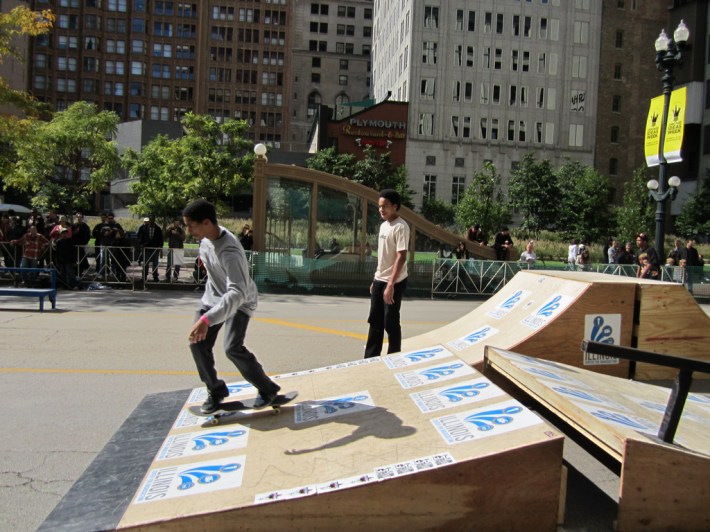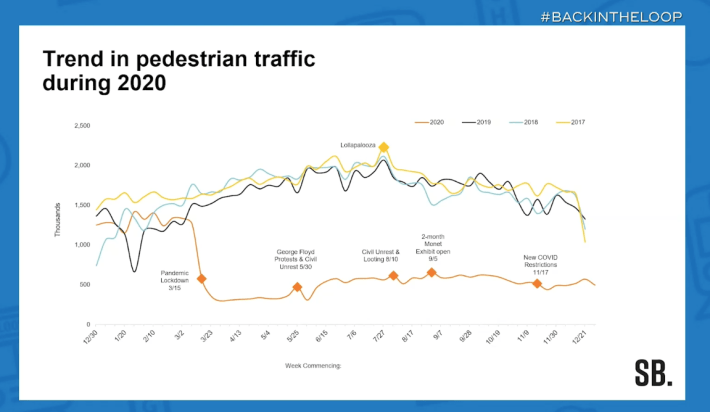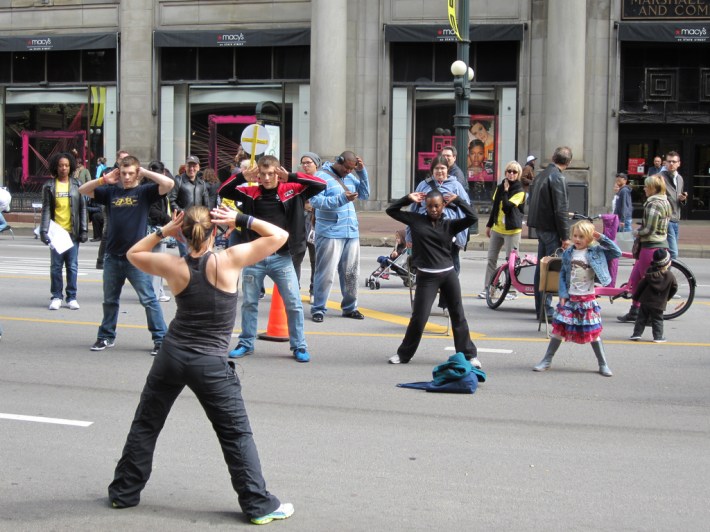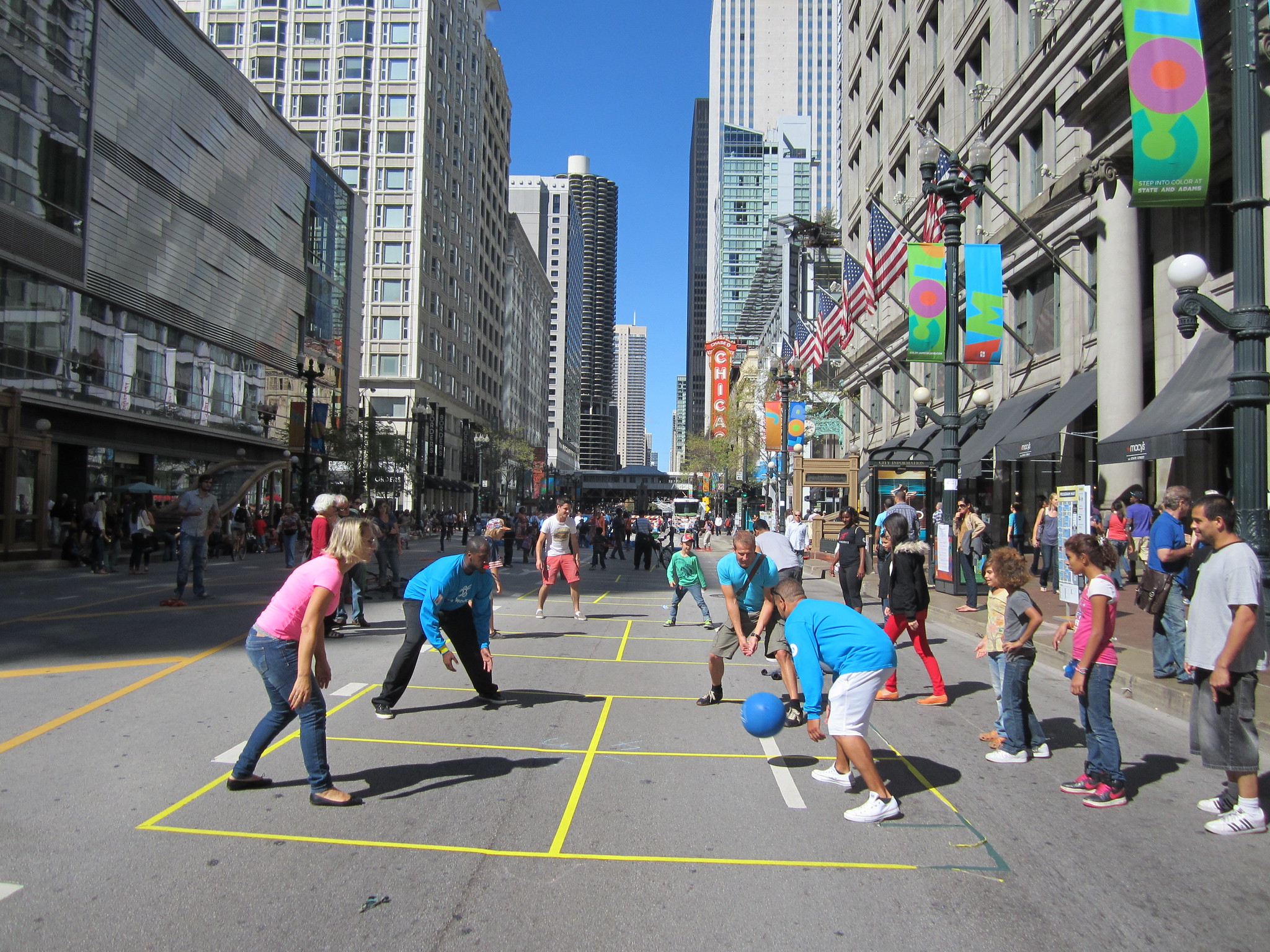Open Streets events, in which roadways are opened up for recreation and programming, have been successful in U.S. cities like New York, Los Angeles, and Portland. But Chicago's Open Streets Program, which was staged and funded by the Active Transportation Alliance, fizzled out in 2014 due to lack of financial and organizational support from the city government.
However, one of the most successful of the Chicago Open Streets events was a single event on State Street in 2011, which ATA put on in partnership with the Chicago Loop Alliance, a member-based organization promoting businesses and cultural activities in the Loop. The happening drew hundreds, maybe thousands, of people to bike, scoot, skateboard, do aerobics, play with giant blocks, compete in four square, and lounge on Astroturfed "parklets" on the car-free thoroughfare.

Now the Loop Alliance is hoping to create a similarly vibrant scene by hosting up to a dozen Open Streets events on State this year. And their program promises to be a shot in the arm for a downtown that is still struggling with the effects of the COVID-19 pandemic.
Across the country the coronavirus has transformed bustling city centers into ghost towns, and Chicago is no exception. High-rise office buildings once packed with white collar workers now stand mostly empty and, as businesses and employees increasingly settle into remote work, the question of what downtowns like the Loop will look like post-pandemic looms large.
Last week, the Loop Alliance discussed its Open Streets strategy at a refreshingly optimistic annual meeting that envisioned a downtown in which office work makes a moderate recovery and cultural life flourishes.
The keynote speaker for the online event was Diane Wehrle, a founder of Springboard, the U.K.-based company that provides data from 16 pedestrian counters situated along State Street from Wacker to Ida B. Wells Drive for monthly recovery reports CLA has been generating since last July. Wehrle presented data from the State Street counters, comparing them to cities across the U.S. and the U.K.

The charts reflected what you see any day in the Loop since March 2020: a precipitous drop in activity that has yet to recover. However, Wehrle was upbeat about people returning downtown for business and recreation based on trends in the U.K., which is currently ahead of the U.S. in vaccinations. “Every week we’re seeing increases in pedestrian traffic. People are desperate to get out there. We’ll undoubtably see a resurgence.”
A resurgence, yes, but a likely partial one, at least in terms of in-person office work. “We’re anticipating a more hybrid model,” Wehrle said. “At the same time, that absence of collaboration is very stark. I think we’re all quite Zoomed-out and we want to see people. As people come back in this hybrid model, it may change [commute] patterns throughout the day. They may come in later or stay out longer to make more of their trips when they come in the city.”

Jean de St. Aubin, CLA Board Chair (and executive director of the Gene Siskel Film Center) presented plans for 2021 that centered around cultural activities to entice people downtown for reasons other than work: pop-up art galleries in vacant retail spaces, Broadway in Chicago musical performances on the Riverwalk, and notably, the conversion of State Street into a pedestrianized Open Street on Sundays throughout the summer.
After the meeting I spoke with Kalindi Parikh, Director of Planning at the Loop Alliance. Most of the details for Sundays on State are to be determined, but Parikh said the general plan is open State from Lake Street to Madison (allowing east-west vehicular traffic to cross the route) for up to 12 Sundays from July to September, transforming the iconic thoroughfare into a public plaza hosting pop-up performances, free fitness classes and other wellness activities, as well as expanded outdoor dining and retail space.

Parikh couldn’t say if the program would continue after pandemic restrictions are lifted, indicated that if the program is deemed successful, that may be a possibility. “CLA has done a lot of thinking about the future of our streets,” she said. “Weekends are so different than weekdays in the Loop. This strikes me as an opportunity to give them a better version of that. I’m curious what we learn from this iteration.”
I asked Parikh if the Loop Alliance had any updates on reopening the Chicago Pedway System which, with the exception of the bottom level of Block 37, a corridor connecting the CTA Red and Blue lines' Washington stations, has remained closed during pandemic restrictions. She said the reopening date will likely be sometime this spring or summer, but it's not clear exactly when, largely because some sections of the Pedway are owned by the city and some by private buildings. “It’s hard to do things because there are so many players. We’re trying to coordinate this now.”
Parikh did say that the Loop Alliance supports allowing dockless electric rental scooters to be parked in the Loop this year, in contrast to the 2020 pilot. While the city and the Active Transportation Alliance have voiced concerns about scooters being carelessly parked and ridden on downtown sidewalks, CLA views the current reduced car traffic volumes as an chance to introduce another downtown commuting mode.
“There were fears about traffic, but streets have quieted down,” Parikh said. “If we [introduce the scooters] early people will learn to share those spaces and learn to use them better, so we can be a more multi-modal downtown. Also considering some people are afraid to ride CTA downtown, it can be a good option to commute or commute the last mile.”
During the annual meeting presentation, Loop Alliance CEO Michael Edwards mentioned efforts to connect people experiencing homelessness with services, including a pop-up resource center at the Harold Washington Library and the installation of portable toilets throughout the Loop. I asked Parikh if these amenities, beneficial in non-pandemic times, might also become permanent. “Personally, I hope they do,” she said. “Elevate State, a large visioning process CLA leads for State Street, has been paused. We’re hoping to resume later this year, and topics like this are top of mind. It plays into the ‘everyone’s neighborhood’ campaign as well. Making sure everyone can navigate the Loop and be able to use a restroom.”




